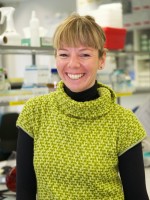2014 SwissTB Award
PhD Sònia Borrell
 Bacteria that are resistant to multiple antibiotics are a growing threat to global health. Studies focusing on single antibiotics have shown that resistance to these drugs is often associated with bacteria losing part of their virulence. However, little is known about the virulence of bacteria resistant to multiple antibiotics. We used Mycobacterium smegmatis as a model for human tuberculosis (TB), and competitive growth experiments as a proxy for bacterial “virulence” or “fitness”. For this, strains of interest are grown together in a common environment (i.e. a culture flask) and left to compete for the limited resources contained in the growth media. We used this assay to study strains harbouring mutations conferring resistance to both rifampicin and ofloxacin, two of the most important anti-TB drugs. We found that these strains had a higher fitness than expected, suggesting that the two mutations together have a positive impact on bacterial survival compared to harbouring just one of these mutations (a phenomenon called “epistasis” in molecular biology). We then screened 151 highly drug-resistant clinical isolates of Mycobacterium tuberculosis, which is the real TB pathogen, and found that the particular combinations of rifampicin- and ofloxacin resistance-conferring mutations that were associated with higher fitness in our M. smegmatis model were the most frequent in the clinical isolates. This indicates that these particular combinations of drug-resistance mutations are advantageous to the bacteria and rather than making them less virulent, might in fact enhance the propagation of these highly drug-resistant TB bacteria.
Bacteria that are resistant to multiple antibiotics are a growing threat to global health. Studies focusing on single antibiotics have shown that resistance to these drugs is often associated with bacteria losing part of their virulence. However, little is known about the virulence of bacteria resistant to multiple antibiotics. We used Mycobacterium smegmatis as a model for human tuberculosis (TB), and competitive growth experiments as a proxy for bacterial “virulence” or “fitness”. For this, strains of interest are grown together in a common environment (i.e. a culture flask) and left to compete for the limited resources contained in the growth media. We used this assay to study strains harbouring mutations conferring resistance to both rifampicin and ofloxacin, two of the most important anti-TB drugs. We found that these strains had a higher fitness than expected, suggesting that the two mutations together have a positive impact on bacterial survival compared to harbouring just one of these mutations (a phenomenon called “epistasis” in molecular biology). We then screened 151 highly drug-resistant clinical isolates of Mycobacterium tuberculosis, which is the real TB pathogen, and found that the particular combinations of rifampicin- and ofloxacin resistance-conferring mutations that were associated with higher fitness in our M. smegmatis model were the most frequent in the clinical isolates. This indicates that these particular combinations of drug-resistance mutations are advantageous to the bacteria and rather than making them less virulent, might in fact enhance the propagation of these highly drug-resistant TB bacteria.
Publication
Sonia Bòrrell1,2, Youjin Teo1,2, Federica Giardina1,2, Elizabeth M. Streicher3, Marisa Klopper3, Julia Feldmann1,2, Borna Müller1,2,3, Tommie C. Victor3, Sebastin Gagneux1,2
1 Departement of Medical Parasitology and Infection Biology, Swiss Tropical and Public Health Institute, Basel
2 University of Basel
3 DST/NRF Centre of Excellence for Biomedical Tuberculosis Research/MRC Centre for Molecular und Cellular Biology, Division of Molecular Biology and Humand Genetics, Faculty of Health Sciences, Stellenbosch University, Cape Town
